IAC News
IAC News No.96, October 2020
Japan Society of Civil Engineers International Activities Center October 1, 2020 IAC News No.96
Conservation Project of the U.K.'s Oldest Active Road Suspension Bridge (Union Suspension Bridge)
- Background to the Large-Scale Restoration Work and Conservation Project -
In the previous issue (No. 95), we reported on the presentation of a plaque from the Japanese, British, and American Society of Civil Engineers to commemorate the 200th anniversary of the construction of the world's oldest suspension bridge, which celebrated its bicentennial anniversary on July 26. In this issue, we will take a look at the background up to the beginning of the conservation project that was started to mark the bridge’s 200th anniversary.
The Civil Engineering Heritage Value of the Union Suspension Bridge
The Union Suspension Bridge, which links the borders between Scotland in the north of the United Kingdom and England, is the first suspension bridge to have seen the fully-fledged use of wrought iron for the suspension materials. The width of the bridge is 5.5 m, and its span of 133 m (cable span of 136 m) was the longest in the world up to the completion of the United Kingdom’s Menai Suspension Bridge 6 years later. Although there was a 2 ton weight limit, it had been continually used as the oldest active road suspension bridge that allowed cars to pass over it. As the world’s oldest active road suspension bridge, it has even been registered in the Guinness World Records.
The historical significance of the Union Suspension Bridge from a civil engineering point of view lies in it being the starting point of the development of modern suspension bridges; from numerous bridge’s which have held the mantle of the world’s longest suspension after the Union Suspension Bridge in 1820, right up to the 1991-meter-long Akashi Kaikyo Bridge constructed in 1998. What achieved this was the fully-fledged use of iron for the suspension materials of the structure, and it can be said to be the starting point for modern suspension bridges that paved the way for Akashi Kaikyo Bridge. For Japan, a country that boasts the world’s longest suspension bridge at the start of the 21st century, the Union Suspension Bridge carries great significance in terms of its civil engineering history.
How the Union Suspension Bridge Overcame Possible Closure
Until the start of the large-scale restoration works that began recently, as reported in the previous issue, there was an academic collaboration to assess the bridge’s civil engineering heritage undertaken by three academic societies that offered support in terms of helping to acquire funds for the restoration work.
The world’s oldest active road suspension bridge has seen aging advance most notably in recent years, with parts of the bridge suffering severe deterioration. In 2007, there were multiple incidents where the hangers became disconnected from the bridge. Although the bridge has undergone temporary repairs and has remained open with a weight limit, because a lack of funds for full-scale restoration meant it was difficult to guarantee the future safety of those using the bridge, it was rumored that the bridge may have had to have been closed in the near future. The National Trust, on the other hand, designated it as ‘Heritage at Risk’ (a cultural heritage site at risk of being lost forever) and encouraged a full-scale conservation and restoration project for the bridge to live on.
Cooperation in Valuing Civil Engineering Heritage
The Institution of Civil Engineers (ICE) supported these activities from an academic perspective of civil engineering heritage conservation, and because it was necessary to show the universal value of civil engineering heritage in order to make full-scale conservation a reality, individuals related to civil engineering history at American Society of Civil Engineers (ASCE) and the Japan Society of Civil Engineers (JSCE) were invited to cooperate to gain international support to help breathe new life into the bridge.
Although each of the three societies in Japan, the United Kingdom, and the United States has their own criteria for assessing civil engineering heritage, the three societies reached a unanimous decision regarding the civil engineering heritage assessment of the world’s oldest active road suspension bridge that links to modern day suspension bridge technology. How to make this fact widely known to the general public was an issue these societies faced when joining forces.
The Society of Civil Engineers of the aforementioned three countries were a great help in securing funds for the restoration work by explaining to the National Lottery Heritage Conservation Fund (NLHF) about the value of the civil engineering heritage of the world’s oldest existing road suspension bridge and how highly renowned it is internationally. The setting of the bridge as an International Historic Civil Engineering Landmark (IHCEL) in the review stage proved to be a big plus in securing funds for the project.
Large-Scale Restoration Work
The large-scale restoration work that began in celebration of the 200th anniversary since the bridge was first constructed will see the anchorage, a pivotal part of the structure of the suspension bridge and for which its movement had been previously reported, replaced with new lock anchors. The wooden decking will also be completely replaced. The masonry towers will also be filled and reinforced, including replacement of some of the stones that make it up. The chain cables and hangers will be temporarily detached, and upon carrying out a detailed inspection of them at a plant, they will be repaired if necessary and any damaged parts will be replaced with new ones. The painting of the iron parts is scheduled to done to recoat them to match the bridge’s original shade as it was in 1821. The wire cables, however, which were added in 1902 in order to strengthen the very top part of the bridge, do not contribute to reinforcing it and are scheduled to be removed to return the bridge back to its original form.
At the site of the bridge, the bridge that has connected Scotland and England for over 200 years will be temporarily removed, leaving behind only the towers. When the restoration work is completed in November next year, the International Historical Civil Engineering Landmark (IHCEL) commemorative plaque, which was presented jointly by the Japanese, British, and American Society of Civil Engineers as reported in the previous issue, will be officially installed at the foot of the bridge.
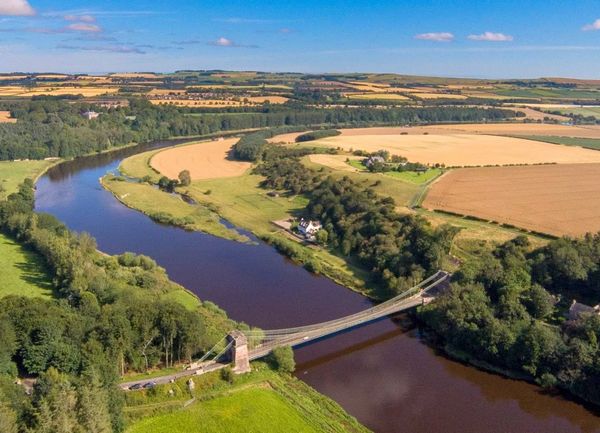
View of Union Suspension Bridge Taken from a Drone
(photo provided by Mr. Roland Paxton)
The left side is Scotland, the right side is England, and the River Tweed between the border of the two countries flows in the direction towards the top of the photo to the North Sea.
©Jim Gibson/The Friends of the Union Chain Bridge
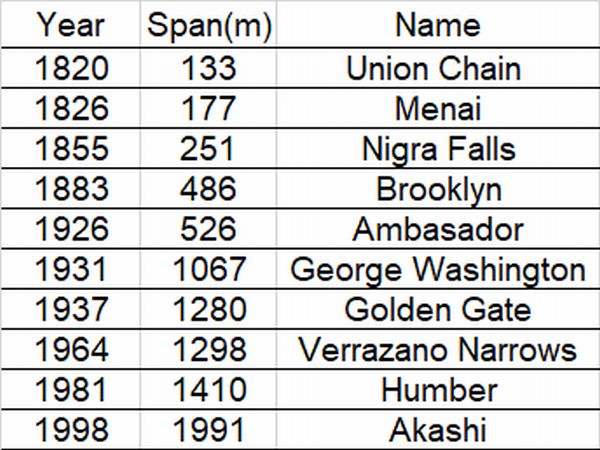
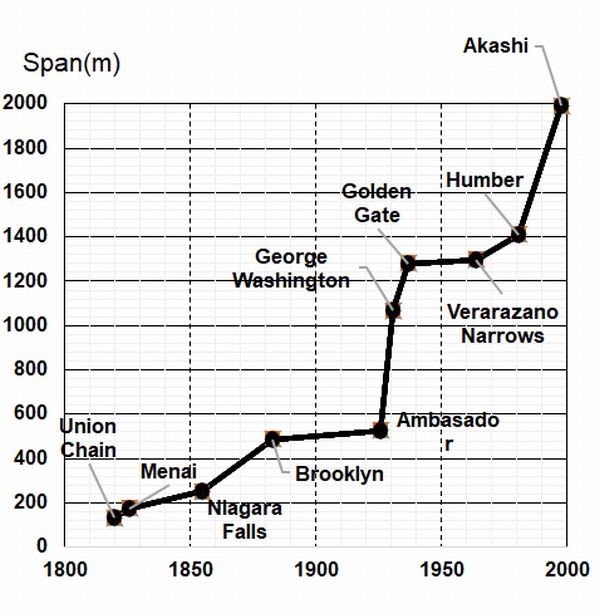
History of the World’s Longest Suspension Bridges
- From the Union Suspension Bridge to Akashi Kaikyo Bridge -
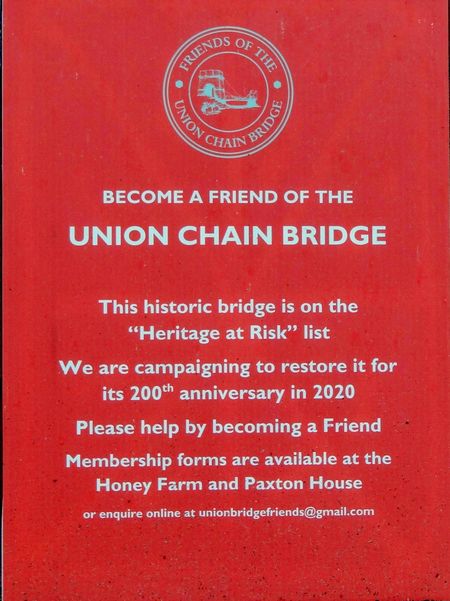
Notice by the Local Conservation Body (2014)
The local conservation body used the fact that the bridge was designated as ‘Heritage at Risk’ to call for support in their activities to conserve the bridge.
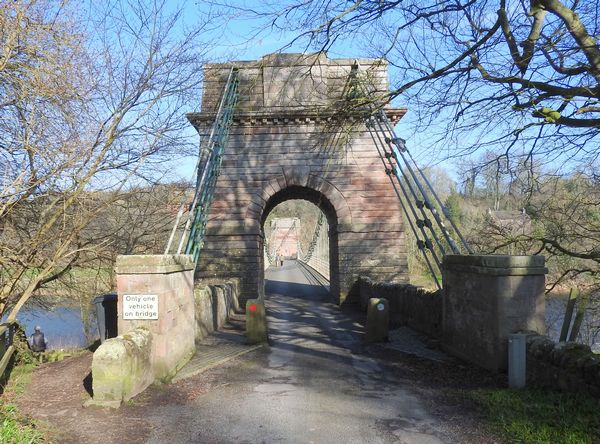
Masonry Tower and Anchorages on the Scotland Side of the Bridge
【Reported by Hiroshi Isohata, Dr. Eng., IAC member, Vice Chair of the Committee of Conservation of Engineering Heritage, JSCE, A former professor of Nihon University】
Committee on Structural Engineering
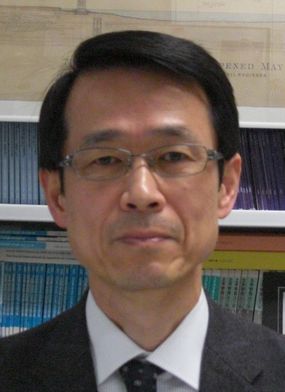
Prof. Hiroshi Katsuchi (The Chair of Committee on Structural Engineering)
The Committee on Structural Engineering was initially established as the Bridge Structure Committee in 1953 as a point of contact for the International Association for Bridge and Structural Engineering (IABSE). In 1971, the Bridge Structure Committee was divided into two separate committees: the Committee on Steel Structures and the Committee on Structural Engineering. Since then, while moving with the times, the Committee on Structural Engineering has been engaged in activities for the planning, designing, and maintenance of social infrastructure facilities and structures such as roads and railways, as well as the research and development of the infrastructures and advanced technologies that support them. In particular, the Committee has a long history of holding structural engineering symposiums (the Committee’s 66th symposium was held in 2020) and issuing annual bridge reports (Bridges in Japan, a publication which was first published in 1967).
There are many sub-committees within the Committee. The permanent sub-committees of the Committee can be roughly divided into three education sub-committees responsible for ongoing education and so on, three editorial sub-committees for editing committee papers, etc., and five liaison sub-committees in charge of contact and collaboration with other academic societies. There are also research sub-committees and special research sub-committees that conduct research on specific topics.
In recent years, the Committee has put together the ‘Common Specifications of Civil Engineering Structures’ (first edition released in 2010, with the revised edition released in 2016) to show the basics such as common matters that go beyond materials and structures, the roles and responsibilities of engineers, structural plans, and performance and effects, etc. In addition, with the deterioration of infrastructure and heightened awareness of maintenance, the Committee had been conducting research on maintenance technologies and tests, however, the ‘Infrastructure Health Check’ issued by the Japan Society of Civil Engineers from 2016 saw the Structural Engineering Committee take charge of the bridge department. Furthermore, in 2019, the Committee published the ‘Introduction to Structural Engineering for Bridge Maintenance’, which explains the knowledge of structural engineering required for practitioners of bridge maintenance. The Committee is also working on the advancement of bridge maintenance (Photo 1 and 2)
The Committee is also actively engaged in activities related to international cultural exchange, and the International Education Sub-committee continues to hold the ‘International Summer Program’ for international students (Photo 3), providing seminars related to the planning, design, construction, and maintenance of structures. The Committee also holds ‘joint seminars’ through an open call for participants from the International Committee, holding seminars in Bangkok in 2003, 2012, and 2018 on the topics of bridge design and the effects of impacts, etc.
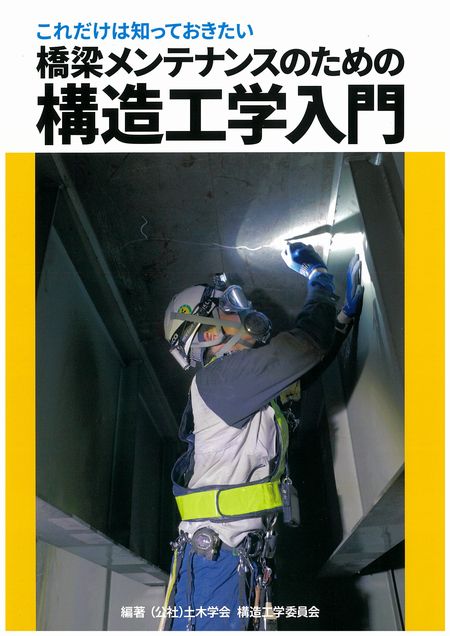
Photo 1 Introduction to Structural Engineering for Bridge Maintenance
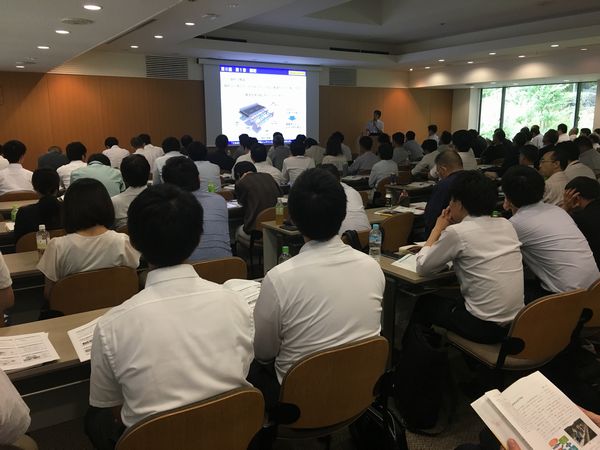
Photo 2 Workshop for Introduction to Structural Engineering for Bridge Maintenance
Photo 3 International Summer Program (2018 Facility Tour)
【Reported by Prof. Hiroshi Katsuchi, The Chair of Committee on Structural Engineering】
The “Talking about 'working in the field of civil engineering in Japan' from various perspectives” (2/3)
The previous part in this series saw us take a look at the profiles of the discussion members and their reasons for coming to Japan. This time, we will focus on the different backgrounds of the members, their employment and work experience in Japan, and their views and suggestions about the Japanese civil engineering industry gained from their experience. This article is packed with hints and will no doubt be of great interest to you all
■ Civil engineering skills and cultural exchange experience gained through work in Japan
Binh: Coming to Japan has taught me to be able to see my home country objectively. I noticed that there are various ways of thinking, with differences in the ways of thinking and systems and so on between Vietnam and Japan. Through the internships and part-time jobs I experienced when I was a student, I learned the meaning behind and enjoyment of going out into society and working. The knowledge and skills I learned at university are serving me in my current job.
Getting a job and having seen the fierce international competition out there, I think the biggest strength of Japanese companies is their ‘ability to see things through’, for example, the ability and attitude to complete a project according to the client's wishes as much as possible. Recently, I feel that the momentum of design offices in Japan is fading. To date, a large number of foundation drawings and structural drawings had been produced in Japan, but recently, labor shortages have seen large jobs be outsourced to Indonesia and India.
Lee: I got the qualifications to become a professional civil and structural engineer in Korea. I came to Japan with the aim of taking my career and skills to the next level. I was anxious at first, but now I am glad that I was able to experience two societies in the form of Korea and Japan. As an individual and a researcher, I make it my job to play the role of a liaison between Japan and Korea. Nowadays in the sellers’ market amid the labor shortage in Japan, it is a good idea, for example, to make good use of university systems such as study abroad programs and graduate schools to connect Korean universities and Japanese companies. Japanese companies will find it easier to secure talented individuals, and Korean students will have more options after they graduate, which will no doubt be beneficial to both parties. Someone like me who has experienced both life and work in Japan and Korea can act as a middleman between the two.
Ha: I learned about Japan through the social contribution activities and volunteer activities I experienced during my time at university, and began to think that I would like to serve as a bridge between Japan and Vietnam. I have always admired Japan’s civil engineering technology and safe and reliable monozukuri (manufacturing). After coming to Japan for the first time, I was surprised at the high level of awareness regarding safety there is in this country. For example, at my company (Central Nippon Expressway Company Limited), safety is our top priority, and everything is kept well organized even at small work sites. I want to make Japanese site management and consideration for safety the norm in Vietnam.
Eakarat: Having worked in Japan, I have all-round experience in the field of specialized prestressed concrete (PC) bridges, from fundamental research to design and construction as well as maintenance. I am also engaged in aging-related work, and can use the experience and skills that I have gained in Japan for the benefit of other countries as well. I would like to continue to contribute to developing the infrastructure of both countries by taking advantage of my expertise.
Binh: In terms of serving as a ‘bridge’, I think about not only ‘being a bridge between Japan and one’s home country’, but also ‘being a bridge between Japan and the world’. I understand the needs of clients aiming to expand their business overseas, and work with designers and builders to create something greater than what they ask for. This is the ability and attitude that I learned while studying abroad, and it is the value that we can all contribute.
What is ‘obvious’ in Japan does not translate overseas. For example, when drawing up specifications in English, saying ‘this is the typical Japanese way of doing things’ does not clear things up, with overseas orderers unable to understand the specifications. I think that what we think of as being ‘obvious’ makes it difficult to introduce or transfer skills overseas.
The members of this discussion studied abroad in Japan before finding employment and continuing to live in Japanese society. They see, through first-hand experience, the differences between Japan and their home countries. This means they have an understanding of the rules, culture, customs, and good points and bad points of both. Because of engineers like the members in the discussion, we will be able to achieve exchanges between Japan and their home countries, as well as other countries, on a personal and technical level, and contribute to the development and improvement of infrastructure in each country and region. There seems to be much, much more we can learn from them.
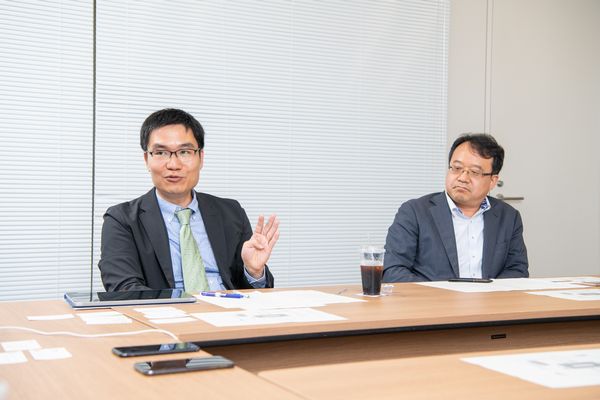
Mr. Binh(left) and Mr. Lee(right)
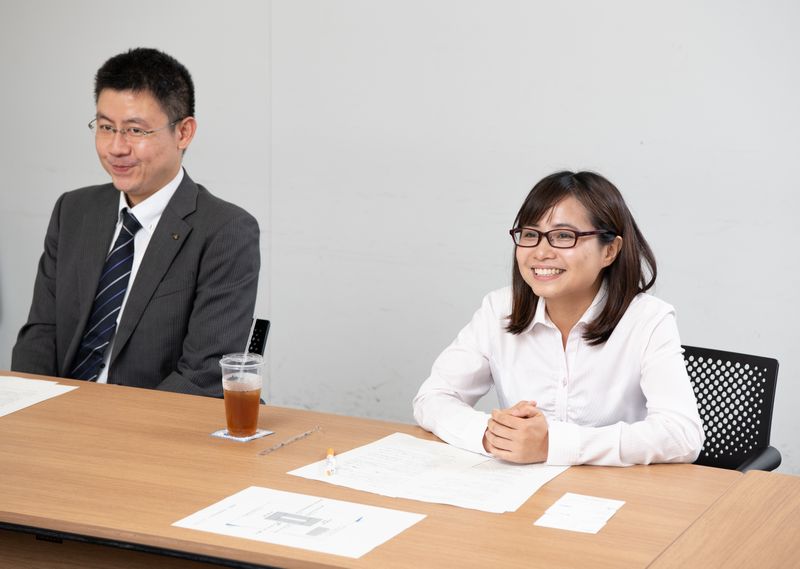
Mr. Eakarat(left) and Ms. Ha(right)
Updates
-
Concrete Committee Newsletter (October 2020)
http://www.jsce.or.jp/committee/concrete/e/newsletter/newsletter60/index.html -
The 2020 International Conference on Sustainable and Innovative Infrastructure (ICSII 2020)
https://www.icsii.net/ -
ASCE Lifelines Conference 2021
https://samueli.ucla.edu/lifelines2021 -
The Second International Conference on Press-in Engineering (ICPE) 2021, Kochi
https://icpe-ipa.org/ -
jhappy - JICA’s Grant Aid Cooperation -
Facebook: https://www.facebook.com/jhappy20161110/
Twitter: https://twitter.com/jhappy_official -
The International Infrastructure Archives
– A Compilation of Japan’s Greatest Projects in Transfer of Civil Engineering Technology in Service –
http://www.jsce.or.jp/e/archive/ - IAC “News Pick Up!!” on the JSCE Japanese website
http://committees.jsce.or.jp/kokusai/iac_dayori_2020
- Summary of featured articles in JSCE Magazine Vol. 105, No.9, September 2020
http://www.jsce-int.org/pub/magazine
- Journal of JSCE
https://www.jstage.jst.go.jp/browse/journalofjsce
IAC News Subscription
The IAC News is one of the communication tools to share information and ideas with the members. We would like to invite you, your friends and colleagues to join the communication and to subscribe the IAC News. Please register online: (http://www.jsce-int.org/node/150). We look forward to meeting you.
